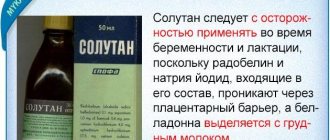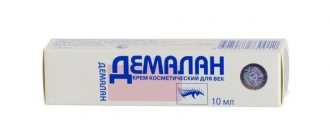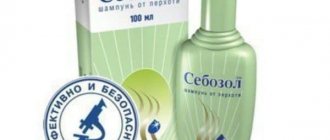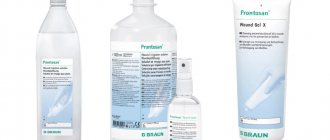Pyrimethamine
International name of the medicinal substance:
Pyrimethamine The list of drugs containing the active substance Pyrimethamine is given after the description.
Pharmacological action:
Antiprotozoal agent;
has antimalarial and antitoxoplasmoid effects. Blocks folate reductase, which converts folic acid into folinic acid. It is active against plasmodia (Plasmodium vivax, Plasmodium falciparum, Plasmodium malariae, causing 3-day, tropical and 4-day malaria, respectively) and the causative agent of toxoplasmosis (Toxoplasma gondii), and has a schizontocidal effect. Shows activity against both plasmodia located in the bloodstream (although somewhat weaker than 4-aminoquinolines) and against plasmodia located in hepatocytes. It does not affect the sexual forms of malarial plasmodium in the human body (devoid of gamontocidal activity), but suppresses the fertilization of gamonts in the body of the carrier (gamontostatic effect). It is sporicidal against Plasmodium falciparum and Plasmodium vivax and may reduce cyclic transmission if used widely. Activity against the causative agent of toxoplasmosis is greatly enhanced when combined with sulfonamides. Pharmacokinetics:
Very well absorbed after oral administration. It is well and quickly distributed in the body, penetrates into the lungs, liver, kidneys, and spleen. Passes through the BBB and creates concentrations in the CSF that are 13-26% of those in the blood. Penetrates the placenta and is excreted in breast milk. Communication with plasma proteins - 87%. Metabolized in the liver. T1/2 in adults is 80-123 hours, but this figure can be reduced to 23 hours in patients with immunodeficiency syndrome. T1/2 in newborns and children under 1 year of age is about 64 hours (from 52 to 87 hours). TCmax - 3 hours (2-6 hours). Cmax in adults after taking 25 mg is 0.13-0.31 mcg/ml; in children under 1 year of age - 1.3 mcg/ml when using a dose of 1 mg/kg. Elimination is carried out by the kidneys (20-30% is excreted unchanged). Removal can last 30 days or more. The concentration of the drug decreases by 47% during peritoneal dialysis.
Indications:
Malaria, toxoplasmosis (congenital and acquired), uveitis (toxoplasmosis or unknown etiology).
Contraindications:
Hypersensitivity, megaloblastic B12-deficiency anemia associated with folic acid deficiency. Caution.
Liver and/or renal failure, folate deficiency conditions. Side effects:
Allergic reactions, rash, insomnia, nausea, spastic abdominal pain, vomiting, diarrhea, arrhythmias, hematuria, megaloblastic B12-deficiency anemia, inhibition of bone marrow hematopoiesis (thrombocytopenia, leukopenia), headache, dizziness, dry mouth or throat , fever, dermatitis, depigmentation, depression, circulatory collapse, ulceration of the oral mucosa, grand mal seizures (with a predisposition to epilepsy);
in newborns - hyperphenylalaninemia; in elderly patients during long-term therapy (1.5 and 2 years) - malignant diseases (granulocytic leukemia, reticular cell sarcoma). Overdose. Symptoms: nausea, vomiting, convulsions, circulatory disorders, depression of the respiratory center. There is no specific antidote. The minimum lethal dose is 250-300 mg (there are reports of recovery in children who swallowed 375-625 mg). Treatment: symptomatic, early gastric lavage. Gastric lavage can have a positive effect only within 2 hours after taking the drug. To combat possible folate deficiency, it is necessary to take calcium folinate until the symptoms of intoxication disappear. Because side effects associated with leukopenia may have a maximum delay of 7-10 days, treatment with calcium folinate should be continued throughout the period of increased risk. Interaction:
Compatible with sulfonamides, quinine.
Strengthens the antifolate effects of folate metabolism inhibitors. Strengthens the myelosuppressive effect of cytostatics, especially methotrexate, which has an antifolate effect, as well as all drugs that inhibit bone marrow hematopoiesis. In patients suffering from acute myelotoxic anemia, co-administration with daunorubicin and cytosine arabinose causes fatal bone marrow aplasia. Increases the toxicity of quinidine, indirect anticoagulants (displaces them from protein binding). Concomitant use of lorazepam causes toxic liver damage. In children with leukemia and central nervous system damage, convulsions may occur during simultaneous administration of methotrexate. Special instructions:
When treating toxoplasmosis, it is necessary to additionally prescribe folate to reduce the risk of bone marrow suppression.
Every week during the entire treatment period and for 2 weeks after its completion, a complete blood count should be performed. If signs of folate deficiency—suppression of bone marrow hematopoiesis—appear, treatment must be interrupted and calcium folinate prescribed. Taking sulfonamides should be accompanied by adequate fluid intake to minimize the risk of crystalluria. Preparations containing the active ingredient Pyrimethamine:
Daraprim, Tindurine, Chloridine
The information provided in this section is intended for medical and pharmaceutical professionals and should not be used for self-medication. The information is provided for informational purposes only and cannot be considered official.
Pyrimethamine
Name: Pyrimethamin Pharmacological action: Antimalarial. It is active against malaria pathogens (P. falcipanim, P. vivax, P. malariae), has a sporontocidal (destroying spores of the pathogen) effect on P. vivax, P. falciparum and can interrupt the cyclic transmission of the pathogen, subject to widespread use of the drug. It is also effective against the causative agent of toxoplasmosis.
Indications for use: Prevention and treatment of malaria; toxoplasmosis (a disease caused by an intracellular parasite and characterized by primary damage to the central nervous system, eyes, skeletal muscles, heart; the source of infection is cats). Primary polycythemia (increased red blood cell count) in case of ineffective radiation therapy.
Method of administration: Before prescribing a drug to a patient, it is advisable to determine the sensitivity of the microflora to it that caused the disease in this patient. To prevent malaria, adults are prescribed 25 mg once a week, children aged 5-10 years - 12.5 mg once a week. Prevention should begin shortly before or immediately after arrival in an endemic area (an area in which malaria has been reported for a long time); the drug should be taken once a week during the entire period of stay in the endemic area, as well as for another 4 weeks after departure. For the treatment of malaria, adults and children over 14 years of age are prescribed 50-75 mg of pyrimethamine in combination with 1.0-1.5 g of sulfalene per dose. Children aged 9-14 years are prescribed 50 mg, 4-8 years - 25 mg, under 4 years - 12.5 mg of pyrimethamine in combination with 1.0, 0.5 and 0.25 g of sulfalene, respectively. For the treatment of malaria, pyrimethamine can be combined with hingamine, with the dose of pyrimethamine being 0.01 g 3 times a day for 3 days. For toxoplasmosis, the drug is prescribed after meals, 25 mg 2 times a day in combination with sulfadimezine. Sulfadimezin is prescribed 1 g 2 times a day. Carry out 2-3 courses of treatment for 7-10 days with breaks of 10 days. Pyrimethamine enhances the myelosuppressive (suppressing bone marrow function) effect of cytostatics (substances that suppress cell division), especially methotrexate. When treating with pyrimethamine, folic acid and vitamin Bp should be additionally prescribed. During treatment, a peripheral blood test should be performed once a week. During treatment, patients should drink plenty of fluids.
Side effects: Rash, nausea, cramping abdominal pain, vomiting, diarrhea, leukopenia (decrease in the level of white blood cells in the blood), thrombocytopenia (decrease in the number of platelets in the blood), anemia (decrease in hemoglobin in the blood), headache, dry mouth, atrophic glossitis (inflammation of the tongue), weakness.
Contraindications: Disorders of erythropoiesis (formation of red blood cells) with anemia, pregnancy, hypersensitivity to the drug. The drug is prescribed with caution to patients with renal and/or liver failure, or with a deficiency of folic acid in the body.
Release form: Tablets, 0.025 g.
Storage conditions: List B. In a dry place, protected from light.
Synonyms: Daraprim, Tindurine.
Attention! The description of the drug “ Pyrimethamine ” on this page is a simplified and expanded version of the official instructions for use. Before purchasing or using the drug, you should consult your doctor and read the instructions approved by the manufacturer. Information about the drug is provided for informational purposes only and should not be used as a guide to self-medication. Only a doctor can decide to prescribe the drug, as well as determine the dose and methods of its use.
Pyrimethamine - instructions for use, analogues, composition, indications
Antimalarial drug. It is active against malaria pathogens (P. falcipanim, P. vivax, P. malariae), has a sporontocidal (destroying spores of the pathogen) effect on P. vivax, P. falciparum and can interrupt the cyclic transmission of the pathogen, subject to widespread use of the drug. It is also effective against the causative agent of toxoplasmosis.
Indications for use:
Prevention and treatment of malaria; toxoplasmosis (a disease caused by an intracellular parasite and characterized by primary damage to the central nervous system, eyes, skeletal muscles, heart; the source of infection is cats). Primary polycythemia (increased red blood cell count) in case of ineffective radiation therapy.
Mode of application:
Before prescribing a drug to a patient, it is advisable to determine the sensitivity to it of the microflora that caused the disease in this patient. To prevent malaria, adults are prescribed 25 mg once a week, children aged 5-10 years - 12.5 mg once a week. Prevention should begin shortly before or immediately after arrival in an endemic area (an area in which malaria has been reported for a long time); the drug should be taken once a week during the entire period of stay in the endemic area, as well as for another 4 weeks after departure. For the treatment of malaria, adults and children over 14 years of age are prescribed 50-75 mg of pyrimethamine in combination with 1.0-1.5 g of sulfalene per dose. Children aged 9-14 years are prescribed 50 mg, 4-8 years - 25 mg, under 4 years - 12.5 mg of pyrimethamine in combination, respectively, with 1.0, 0.5 and 0.25 g of sulfalene. For the treatment of malaria, pyrimethamine can be combined with hingamine, with the dose of pyrimethamine being 0.01 g 3 times a day for 3 days. For toxoplasmosis, the drug is prescribed after meals, 25 mg 2 times a day in combination with sulfadimezine. Sulfadimezin is prescribed 1 g 2 times a day. Carry out 2-3 courses of treatment for 7-10 days with breaks of 10 days. Pyrimethamine enhances the myelosuppressive (suppressing bone marrow function) effect of cytostatics (substances that suppress cell division), especially methotrexate. When treating with pyrimethamine, folic acid and vitamin Bp should be additionally prescribed. During treatment, a peripheral blood test should be performed once a week. During treatment, patients should drink plenty of fluids.
Side effects:
Rash, nausea, cramping abdominal pain, vomiting, diarrhea, leukopenia (decrease in the level of leukocytes in the blood), thrombocytopenia (decrease in the number of platelets in the blood), anemia (decrease in hemoglobin in the blood), headache, dry mouth, atrophic glossitis ( inflammation of the tongue), weakness.
Contraindications:
Disturbances of erythropoiesis (formation of red blood cells) with anemia, pregnancy, hypersensitivity to the drug. The drug is prescribed with caution to patients with renal and/or liver failure, or with a deficiency of folic acid in the body.
Release form:
Tablets 0.025 g.
Storage conditions:
List B. In a dry place, protected from light. Synonyms: Daraprim, Tindurine. Attention! Before using Pyrimethamine, you should consult your doctor. This instruction is given in free translation and is intended for informational purposes only. For more complete information, please refer to the manufacturer's instructions.
general information
- Sales form:
over-the-counter
- Current issue:
Sulfadoxine
- Manufacturer:
Piluli











